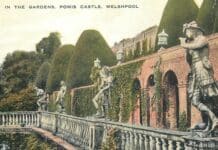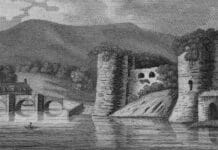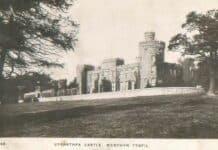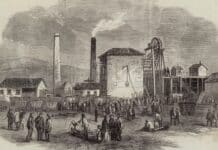CLAIRE BARRAND picks out eight historical changelig cases in Wales, with shocking eyewitness accounts of Welsh changelings…
Historically in Britain, children born with disabilities were have been sadly believed to be changelings. Widely accepted as an evil exchange of a human baby for a fairy one.
Belief in changelings was particularly widespread in Celtic locations including Wales.
“Tylwyth Teg,” (Welsh fairies) or “Fair folk” were thought to have sought-after human babies and would steal them whenever they could, swapping them with a poor weak substitute of fairy descent. The new fairy baby displayed crabbiness and ugliness which would be visible.
The distraught families, upon suspecting their child to have been “swapped” would seek the most horrific solutions to the problem, often employing a “fairy doctor” to diagnose the child as a fairy using various torturous methods which would lead to the death of the poor child. Some practices involved burning the child with hot coals, holding them over a fire or boiling water, leaving them exposed to the elements, or drowning them in the belief that the fairies would rush to save their own and give back the “real” child. Such was superstition and so intense was the fear of the fair folk, this practice was sadly common and widespread.
Unchristened children were thought to be most at risk as were girls and twins. In all households, there were routine precautions aimed to prevent child theft. A prevalent one involved putting fire tongs over a cradle, because of the fairies’ well-known antipathy to iron.
Downing Flintshire
Fairy residences are countless in the woods and glens of North Wales. Author Mr. Pennant of History of Whiteford and Holywell 1792, mentions a fairy tree, a massive oak situated on a mound on his own estate at Downing, in Flintshire. He wrote:
“In this very century a poor cottager, who lived near the spot, had a child, who grew uncommonly peevish. The parents attributed this to the fairies and imagined that it was a changeling. They took the child, put it in a cradle, and left it all night beneath the tree, in the hope that the Tylwyth Teg or fairy folk would restore their own before the morning. When the morning came, they found the child perfectly quiet, so went away with it, quite confirmed in their belief.”.
Montgomeryshire
In the parish of Trefeglwys, near Llanidloes, Montgomery, a little shepherd’s cottage dubbed the Place of Strife, on account of the trouble recorded there. A couple that once resided there had twins, when they were a few months old the wife went to to the house of neighbors, leaving both babies alone. When she returned, she saw the “blue petticoats of the old elves” fleeing from her home. Hurrying indoors, she found her house as she had left it and was relieved. However, as the weeks rolled by, she noticed her twins growth seemed stunted. Her husband accused them of not being his, and it caused a huge rift between them. A local wise man gave this advice.
He told her that when she was preparing dinner for the harvesters, in sight of the twins she was to empty the shell of an egg and fill it with pottage. Then carry it out to the workers as if meant to feed them all. But he told her to listen to what the twins say to each other about this strange behavior. If they discuss it in ways that children should not understand, then she should take them both to the river Llyn Ebyr and throw them both in. She did as she was told and heard the twins say;
Acorns before oak I knew;
An egg before a hen;
Never one hen’s egg-shell stew
Enough for harvestmen!
On hearing this, the mother took the two children and threw them into the Llyn, and sure enough, saw goblins in their blue trousers come to save their dwarfs. The mother had her own children back again, and all was well once more.
The Corwrion Changeling Legend
An almost identical tale to the Montgomeryshire case was also recorded and known as the Corwrion Changeling Legend. A mother was advised by a local witch from Tyddyn Y Barcut to throw both children into the river because she suspected them not to be human, but changelings. It was reported that she too returned home to find her “real” children had returned.
Ebwy Fawr (Ebbw Vale)
In Wirt Sykes British Goblins, Welsh Folklore he writes that a Dazzy Walter, the wife of Abel Walter, of Ebwy Fawr, one night in her husband’s absence awoke in her bed and found her baby had gone. Terrified, she searched around her bed for it and grabbed it with her hand above the bed, which was as far as the fairies had managed to carry it. And a woman called Jennet Francis, of that same valley of Ebwy Fawr, said that one night in bed she felt her infant son being taken from her arms; after that, she screamed and hung on, and, as she phrased it, ‘God and me were too hard for them.’ This son later grew up and became a famous preacher of the gospel.
Monmouthshire
Edmund Jones, a famous preacher who lived in Monmouthshire in the 18th century, was firmly convinced of the existence of fairies, claiming to have seen them himself numerous times and he also believed in changelings. He describes a son of a neighbor of his, a Mr. Edmund John William, who was supposed to have been changed by the fairies, “leaving an idiot in his stead.”
Gors Goch is a small rural village near Lampeter in the county of Ceredigion, Wales.
The Legend of Gors Goch. A happy family lived in the small rural village near Lampeter in the county of Ceredigion. One evening they retired to bed but could not sleep because of a noise outside. When the master of the house finally decided to go out, he found himself trembling as he asked who was there. In response, he heard a clear sweet voice reply;
“We want a warm place where we can tidy the children.”
The door was opened, and they entered and began to wash their faerie children. When done, they began to sing and dance until the early hours, and in thanks, they left a gift of money. They came back regularly. However, one day the Tylwyth Teg decided to take the families, young baby. The usually sweet, pretty and affectionate little girl was replaced by an ugly thin, sickly child that cried nonstop. The wife died of a broken heart, and so did all the other children. However, the husband continued to raise the fairy child alone who eventually became the heir of a large farm in North Wales, and that is why the old people used to say, “Shoe the elf with gold and he will grow.”
Some children did survive childhood, however, and a couple of adult changelings were rumoured to exist and so gained local notoriety for this.
Llanover
The Llanover estate when run by Lady Llanover in the 19th century was rife with rumours of the fairies amongst the gardeners who worked there. Several accounts were recorded, and it was said that Twlyth Teg would change children in the area. One family who would regularly leave out offerings of bread and milk for the Fae had a son who decided it was funny to replace the bowl of milk with urine. On finding it, the angry fairies threw the contents around the room and placed a curse as punishment that there would always be a fool – an idiot who would never prosper in his family. Sure enough one of his own children in later years turned out to be one and this continued in every generation since.
A woman by the name of Nani Fach was also said to be the offspring of the fairies as she was presumably “different.” House staff of Lady Llanover would throw crumbs of bread on the floor before going to bed at night as offerings to the fairies such was their fear of them.
Nant Gwrtheyrn changeling
A man by the name of Elis Bach at Nant Gwrtheyrn North West Wales lived, and it was said that his legs were so short that his body seemed only a few inches from the ground when he walked. His voice was squeaky and small. Everyone believed Elis to have been a changeling.









